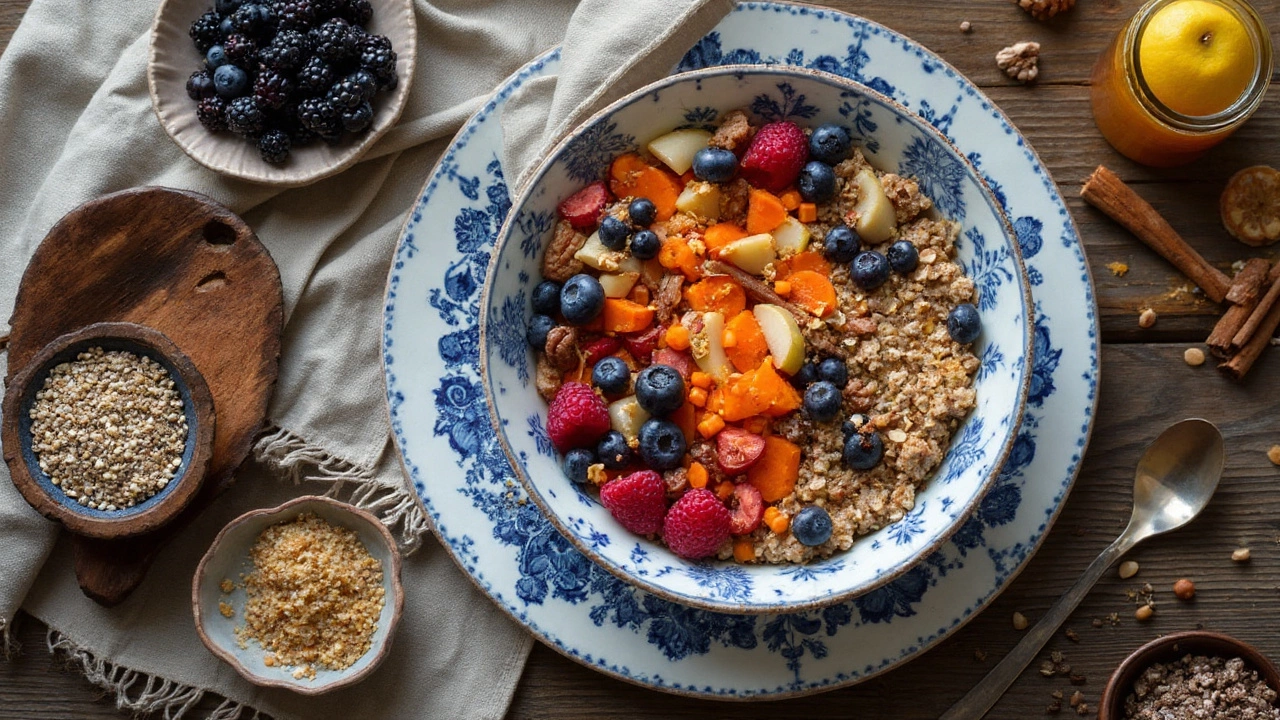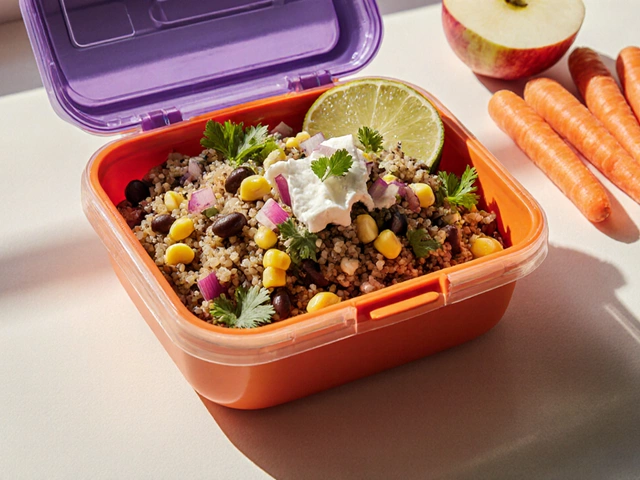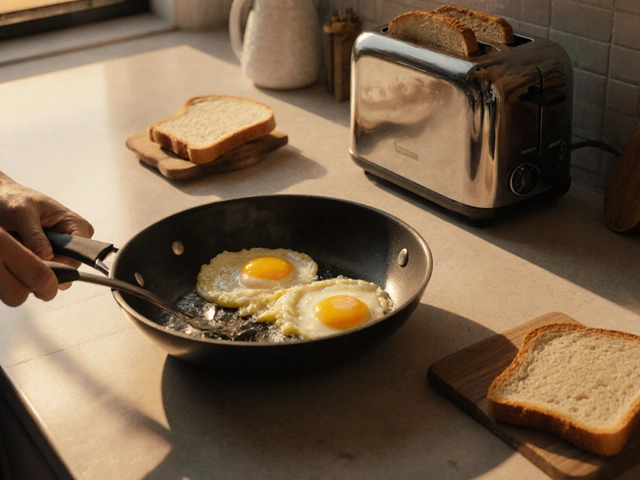
You want one breakfast that wins on health, cost, and taste? The short answer: an oatmeal power bowl built with fiber, protein, and color. It’s boring in the best possible way-predictable results, steady energy, and real science behind it. Meet the quiet champion:
Oatmeal is a whole-grain breakfast made from oats (rolled, steel-cut, or instant) that delivers soluble fiber (beta-glucan), steady-release carbs, and key minerals like magnesium and iron. A typical 40-50 g dry serving offers ~4-5 g fiber, ~6-7 g protein, and supports lower LDL cholesterol when eaten regularly.
TL;DR
- The world’s most practical healthy breakfast is an oatmeal bowl with protein (e.g., Greek yogurt or eggs), nuts/seeds, and fruit.
- Oat beta-glucan (about 3 g/day) can reduce LDL cholesterol by ~5-10% according to FDA- and EFSA-recognized evidence.
- It’s fast (5 minutes), cheap (often under NZ$3/serving), and easy to adapt (gluten-free certified oats, dairy-free milk, vegan protein).
- For lower-carb needs, swap the oat base for a Greek yogurt or tofu base using the same add-ins.
- Build it using the PFF rule: Protein + Fiber + Fat, then add color (berries) for polyphenols.
How I judged “world’s No.1”
I used criteria that actually affect your day: nutrient density (fiber, protein, micronutrients), cardiometabolic impact (LDL, glycemic load), satiety (do you stay full?), time and cost, and how adaptable it is to different diets. Oats hit all of these without fancy gear or pricey packets. A bowl travels across cultures too-porridge has been breakfast in Scotland, Northern Europe, and parts of Asia for centuries.
Glycemic index is a scale that ranks how fast foods raise blood glucose. Rolled oats are typically low-to-medium GI (~55), steel-cut oats tend to be lower (~50-52). Adding protein/fat (yogurt, nuts) and viscous fiber (beta-glucan) can reduce the glycemic effect of the meal.
Why oats win the health math
One word: fiber. Not just any fiber-the thick, gel-forming kind called beta-glucan. That gel traps bile acids in the gut, nudging your liver to pull LDL cholesterol from your blood to make more. Decades of data back this up.
Beta-glucan is a soluble fiber found in oats and barley that forms a viscous gel in the intestine and is associated with 5-10% reductions in LDL cholesterol when ~3 g/day is consumed. Many 40 g oat servings provide about 1.5-2 g, so two bowls or one bowl plus oat bran can reach the 3 g mark.
It’s not just lipids. Oats are rich in manganese, magnesium, and a bit of iron. They’re gentle on the wallet, and they play well with others. Add Greek yogurt for protein, fruit for antioxidants, and nuts or seeds for healthy fats. This combo slows digestion, steadies appetite, and keeps your brain on an even keel till lunch.
For authority: the U.S. FDA, Health Canada, and the European Food Safety Authority all recognize the cholesterol-lowering effect of oat beta-glucan. Harvard T.H. Chan School of Public Health ranks oats among top whole grains for cardiovascular health. None of that means oats cure disease-it means they’re a smart daily habit that moves the needle.
The World’s No.1 Healthy Breakfast: the Oatmeal Power Bowl
Think of this as a template. Swap toppings to fit your taste and goals, but keep the protein-fiber-fat backbone.
Greek yogurt is a strained yogurt higher in protein (typically ~15-18 g per 170 g/6 oz) with a creamy texture and live cultures. Choose plain to avoid added sugar; 2% fat balances taste and satiety.
Blueberry is a berry rich in anthocyanins (polyphenols tied to vascular health). A 75-100 g serving adds ~2 g fiber and natural sweetness with a modest glycemic load.
Almond is a tree nut providing vitamin E, magnesium, and ~6 g protein and ~4 g fiber per 30 g. Even 10 g (about 6 almonds) adds crunch, healthy fats, and satiety.
Chia seed is a seed high in fiber (~4-5 g per tablespoon), plant omega‑3 ALA (~2.5 g), and forms a gel that thickens bowls and slows glucose absorption.
Flaxseed is a seed rich in lignans and ALA omega‑3. Ground flax (~1 tablespoon) offers ~3 g fiber and mixes easily; grinding improves nutrient bioavailability.
Base recipe (5 minutes)
- Rolled oats: 40-50 g (½ cup)
- Water or milk (dairy or unsweetened soy/oat milk): 200-250 ml
- Plain Greek yogurt: 150-170 g (or plant protein option below)
- Blueberries (fresh or frozen): 75-100 g
- Almonds (roughly chopped): 10-15 g
- Chia or ground flax: 1 tablespoon
- Pinch of cinnamon and a small pinch of salt
Microwave method: mix oats and liquid in a bowl, microwave 2-3 minutes, rest 30 seconds. Stir in cinnamon and salt. Top with yogurt, blueberries, nuts, and seeds.
Stovetop method: simmer oats and liquid 3-5 minutes until creamy. Finish with toppings as above.
Macros (typical, using 40 g oats, 170 g 2% Greek yogurt, 100 g blueberries, 12 g almonds, 1 tbsp chia, made with water): ~480-520 kcal, ~26-30 g protein, ~60-65 g carbs, ~14-18 g fiber, ~14-18 g fat (mostly unsaturated). Swap milk for water if you want more calories and creaminess.
Overnight oats (make-ahead)
Combine 50 g rolled oats, 170 ml milk, 170 g Greek yogurt, 1 tbsp chia, cinnamon, and a pinch of salt in a jar. Chill overnight. In the morning, add blueberries and almonds. Texture is pudding-like, and the chia gel bumps fiber. It travels well for commuters and stays safe in a cooler pack for a few hours.
Smart swaps for different goals
- Vegan/plant-based: replace Greek yogurt with 170 g unsweetened soy yogurt or 30 g pea protein powder mixed in. Keep chia/flax for omega‑3 ALA.
- Gluten-free: choose certified gluten-free oats to avoid cross-contact with wheat, barley, or rye.
- Lower sugar: use berries and spices; skip honey/maple. Vanilla extract and cinnamon carry flavor without sugar.
- Lower-carb: halve the oats (25 g) and double the yogurt, or use a yogurt base (no oats) and keep nuts/seeds for crunch.
- Higher calories for athletes/teenagers: cook with milk, add 1 tbsp peanut butter or tahini, and an extra handful of berries or banana slices.
- Savory route: stir in a beaten egg while oats cook (stovetop), then top with avocado and cherry tomatoes. Tastes like risotto, fuels like oats.
Evidence corner (plain-English references)
- FDA and EFSA recognize the health claim: ~3 g/day of oat beta-glucan can reduce LDL cholesterol. Many people reach this by eating one hearty bowl plus an oat bran muffin or swapping to barley in soups.
- Harvard T.H. Chan School of Public Health includes oats in heart-healthy whole-grain patterns and notes fiber’s link to lower cardiovascular risk.
- American Heart Association suggests aiming for 25-38 g fiber/day (women/men). This bowl often covers half your morning target in one shot.
Cost and time: what it looks like in real life
Prices vary by store and season, but here’s a realistic snapshot (NZD, typical 2025 supermarket): rolled oats ~NZ$0.30 per 50 g; plain Greek yogurt ~NZ$1.30 per 170 g; frozen blueberries ~NZ$1.00 per 100 g; almonds ~NZ$0.50 for 12 g; chia ~NZ$0.20 for 1 tbsp. Total: ~NZ$3.30. Time? Five minutes or less, two if you microwave. That’s cheaper than most coffees.
How it stacks up against popular breakfasts
| Breakfast | Fiber | Protein | Added sugar | Glycemic load | Prep time | Cost (NZ$) |
|---|---|---|---|---|---|---|
| Oatmeal Power Bowl (this recipe) | 14-18 g | 26-30 g | 0 g | Low-moderate | 5 min | ~3.3 |
| Sweetened cereal + milk | 2-4 g | 8-12 g | 10-15 g | High | 2 min | ~2.0 |
| Smoothie bowl (banana + juice) | 3-6 g | 10-15 g | 15-25 g | High | 6-8 min | ~5.0 |
| Eggs on white toast | 2-3 g | 12-18 g | 0-2 g | Moderate | 6-8 min | ~3.5 |
| Avocado toast (white bread) | 5-6 g | 4-6 g | 0 g | Moderate | 5-6 min | ~3.8 |
| Greek yogurt parfait (unsweetened) | 4-7 g | 18-24 g | 0 g | Low | 3-4 min | ~3.0-4.0 |

When oats aren’t ideal
- Celiac disease or strict gluten-free: choose certified gluten-free oats or use a Greek-yogurt base instead. Many standard oats have cross-contact with gluten grains.
- Very low-carb/ketogenic diets: a yogurt or tofu base with nuts and seeds fits better. Use a small handful of berries for fiber and color.
- Blood sugar management: stick to 40 g oats, add extra protein (Greek yogurt or egg), keep fruit to 75 g berries, and avoid honey or juice.
- GI discomfort: try steel-cut oats, soak overnight, and introduce gradually. Chia may gel too much for some-switch to ground flax.
- Nut allergy: swap almonds for pumpkin or sunflower seeds.
Alternative “No.1” builds using the same PFF logic
- Protein-forward bowl (no oats): 200 g plain Greek yogurt, 75 g berries, 1 tbsp ground flax, 15 g walnuts, cinnamon. ~300-350 kcal, ~25-30 g protein, ~6-8 g fiber. Low glycemic.
- Tofu breakfast bowl (vegan): 150 g silken tofu blended with 1 tsp vanilla, 1 tbsp peanut butter, 1 tbsp chia; top with 75 g berries. ~350-400 kcal, ~20 g protein, ~10 g fiber.
- Savory whole-grain option: 150 g cooked steel-cut oats stirred with an egg, topped with sautéed spinach and a few avocado slices. High fiber, solid protein, great for those who dislike sweet starts.
Related concepts that connect the dots
Mediterranean diet is a dietary pattern emphasizing whole grains, legumes, vegetables, fruits, olive oil, nuts, and fish, linked to lower cardiovascular risk and better metabolic health. An oatmeal bowl with nuts, seeds, and fruit fits its spirit of fiber-rich, minimally processed meals.
Two more ideas help the bowl make sense: glycemic load (how much glucose a meal actually delivers) and satiety index (how long it keeps you full). Oats with yogurt and nuts keep GL moderate and satiety high by pairing complex carbs with protein and fat. That’s why you don’t get the 10 a.m. sugar crash.
The PFF cheat sheet (Protein + Fiber + Fat + Color)
- Protein: 20-30 g at breakfast tends to curb snacking. Greek yogurt, eggs, or pea/soy protein do the trick.
- Fiber: aim for 10+ g at breakfast to hit 25-38 g/day. Oats, chia, flax, berries.
- Fat: 10-15 g of mostly unsaturated fat (nuts/seeds) improves taste and satiety.
- Color: a handful of deeply colored fruit or veg adds polyphenols (blueberries, raspberries, or even grated carrot in a carrot-cake oat bowl).
Two-minute flavor upgrades (no sugar needed)
- Apple pie oats: grated apple, cinnamon, nutmeg, and walnuts.
- Mocha oats: 1 tsp cocoa + a splash of cooled coffee, top with Greek yogurt.
- Tropical: diced kiwifruit or pineapple with toasted coconut flakes (unsweetened).
- Lemon-berry: lemon zest stirred into oats, topped with blueberries and poppy seeds.
Meal prep playbook
- Batch steel-cut oats: cook 4-6 portions on Sunday; reheat with a splash of milk all week.
- Portion nuts/seeds into mini containers; you’ll stop over-pouring.
- Keep frozen berries in the freezer; they cool hot oats to perfect eating temp.
- Travel hack: overnight oats in a jar, berries in a bag, nuts in a small tin. Assemble on the go.
Precision tweaks for specific needs
- Cholesterol focus: target at least ~3 g/day beta-glucan. One bowl + 1-2 tbsp oat bran or a barley-based soup for lunch closes the gap.
- Hypertension: go light on salt, add potassium-rich toppings (kiwifruit, banana slices, pumpkin seeds) within your plan.
- Iron needs: pair oats with vitamin C sources (kiwi, strawberries) to help plant iron absorption. Tea/coffee after breakfast, not with it.
- Bone health: use a calcium-fortified soy or dairy milk base; add sesame or almonds for extra calcium.
Common pitfalls (and easy fixes)
- Hidden sugar: flavored yogurt or “healthy” granolas can pack 10-20 g added sugar. Use plain yogurt and unsweetened toppings.
- Portion creep: a mountain of nuts doubles calories fast. Stick to 10-15 g (about a tablespoon chopped).
- Too little protein: plain oats alone won’t hold you till lunch. Add 150-170 g Greek yogurt or an egg, or stir in 20-25 g protein powder.
- Texture issues: try steel-cut (chewier), rolled (creamy), or overnight soaked (pudding-like). A tiny pinch of salt wakes up flavor.
Frequently Asked Questions
So… is oatmeal really the world’s No.1 healthy breakfast?
There’s no official world title, but oatmeal with protein, nuts/seeds, and fruit is the strongest all-rounder on health, cost, and practicality. Its beta-glucan fiber is one of the few breakfast components with a recognized LDL-lowering effect, it’s filling, and you can make it anywhere. If oats don’t fit your diet, a Greek-yogurt or tofu base using the same toppings is a close alternative.
How much beta-glucan do I need to lower cholesterol?
Most health authorities cite ~3 g/day of oat beta-glucan for a meaningful LDL reduction (around 5-10% on average). A 40 g serving of rolled oats usually has ~1.5-2 g. Two bowls or one bowl plus oat bran or barley in other meals can reach the target.
Are steel-cut oats healthier than rolled or instant?
All have similar vitamins and minerals. Steel-cut tends to have a slightly lower glycemic impact due to larger particle size. Rolled oats are a practical middle ground, and instant is fine if you pick plain packets without added sugar. The big wins come from what you add: protein, nuts/seeds, and fruit.
What if I’m gluten-free or have celiac disease?
Choose certified gluten-free oats to avoid cross-contact with wheat, barley, or rye. If you’re very sensitive or oats don’t sit well, swap to a Greek-yogurt or tofu base and keep the nuts, seeds, and berries for fiber and healthy fats.
Can I lose weight eating oatmeal for breakfast?
Oatmeal can help because fiber and protein boost fullness, which often reduces snacking. Keep the bowl balanced: 40-50 g oats, at least 20 g protein (Greek yogurt or an egg), and measured nuts/seeds (10-15 g). Avoid sugar add-ins and keep fruit to one handful.
Is honey or maple syrup okay?
You can use a little, but it’s added sugar. Start with spices (cinnamon, vanilla), then fruit. If you still want sweetness, limit to 1-2 teaspoons. For blood sugar goals, skip it and rely on berries or a diced kiwi.
What’s a fast high-protein version without dairy?
Stir 20-25 g pea or soy protein into hot oats and use unsweetened soy milk for the liquid. Top with chia and berries. Texture stays creamy, protein lands in the 25-30 g range, and fiber stays high.
Is skipping breakfast better for my metabolism?
Intermittent fasting works for some people, but if you prefer breakfast, a high-fiber, high-protein bowl supports stable energy and appetite control. It’s less about a magic eating window and more about meal quality and consistency you can keep.
Next steps and troubleshooting
- If you’re hungry before lunch, increase protein to ~30 g (extra yogurt, an egg, or a scoop of protein powder) or add 5 g more fat (a few more nuts).
- If you’re bloated, cut chia to 1-2 teaspoons and cook oats longer with more water. Try ground flax instead of whole seeds.
- If mornings are slammed, batch overnight oats and pre-portion toppings on Sunday night.
- If you’re watching sodium, skip the salt pinch and lean on cinnamon, cocoa, or lemon zest for flavor.
- If weight loss stalls, measure toppings. Nuts and seeds add up quickly; aim for 10-15 g.
One bowl, thousands of variations. Keep the PFF backbone, add color, and you’ll have a breakfast that quietly does the heavy lifting for your day.





